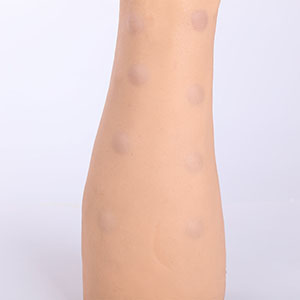Homepageпјҡ NEWS >> Can the intradermal injection model provide more practical experience for medical education?
Intradermal injection is a common medical procedure, often used in clinical areas such as allergen testing and anesthesia. Although this operation seems simple, in practice there are many technical details involved, such as the Angle of the needle, the control of the injection amount, and the positioning of the skin layer. For medical education, how to effectively improve the skills of students in the operation of intradermal injection, especially the ability to cope with different patients, has become an important topic in medical education. As a high simulation teaching tool, whether intradermal injection model can provide more practical experience for medical education has become the focus of academic and industry experts.

Role of models in medical education
Intradermal injection model is an effective tool to provide simulation training and improve operation skills for students. By simulating different features of skin and tissue, the model helps students become familiar with the basic techniques of intradermal injection, such as needle insertion Angle, injection speed, and needle stability. In particular, the simulation of the skin characteristics of different patients (such as obesity, emaciation, sclerosis, etc.) can help students cope with a variety of clinical situations that may be encountered in advance.
Data support: The effect of model training
In a number of medical education studies, intradermal injection model has been widely used in clinical skills training, and its effectiveness has been verified. According to a study published by a medical school in the United States in 2021 , students who trained with the intradermal injection model improved the accuracy of their operating skills by about 30% and were able to effectively reduce errors in operation. The study also showed that through repeated practice in simulated environments, students improved their proficiency in actual operations and were able to adapt more quickly to their physical and psychological reactions when facing patients, reducing their discomfort.
In addition, a 2022 feedback survey of medical students showed that students using the intradermal injection model reported that after simulation training, they were less nervous during the operation and were more comfortable in control of the injection process, especially in complex situations, and were able to quickly assess risks and make decisions. The high simulation design of the model enables students to better cope with possible clinical challenges, thus improving their clinical resilience.
Academic professional perspective
From the academic professional point of view, intradermal injection model is not only a tool for training operational skills, but also a bridge to help students understand the combination of medical theory and practical operation. In the simulation process, students not only complete the action itself, but also think deeply about the principle of each step of the operation, such as why to choose a specific injection Angle, how to avoid possible complications during the injection process. This way of thinking helps students to flexibly apply the theories they have learned in practical clinical practice and improve their comprehensive quality.
Conclusion
As a teaching device, intradermal injection model has proved its importance in medical education. By simulating a variety of clinical situations, it helps students master the fine skills of intradermal injection and improve the accuracy and adaptability of operation. The data showed that students trained with the model were not only able to perform operations with greater precision, but were also able to respond faster and more rationally when faced with clinically complex situations. In addition, model training also promotes the combination of theory and practice of students and improves their comprehensive medical literacy. Therefore, the intradermal injection model not only provides a wealth of practical experience for medical education, but also lays a solid foundation for students' career development.